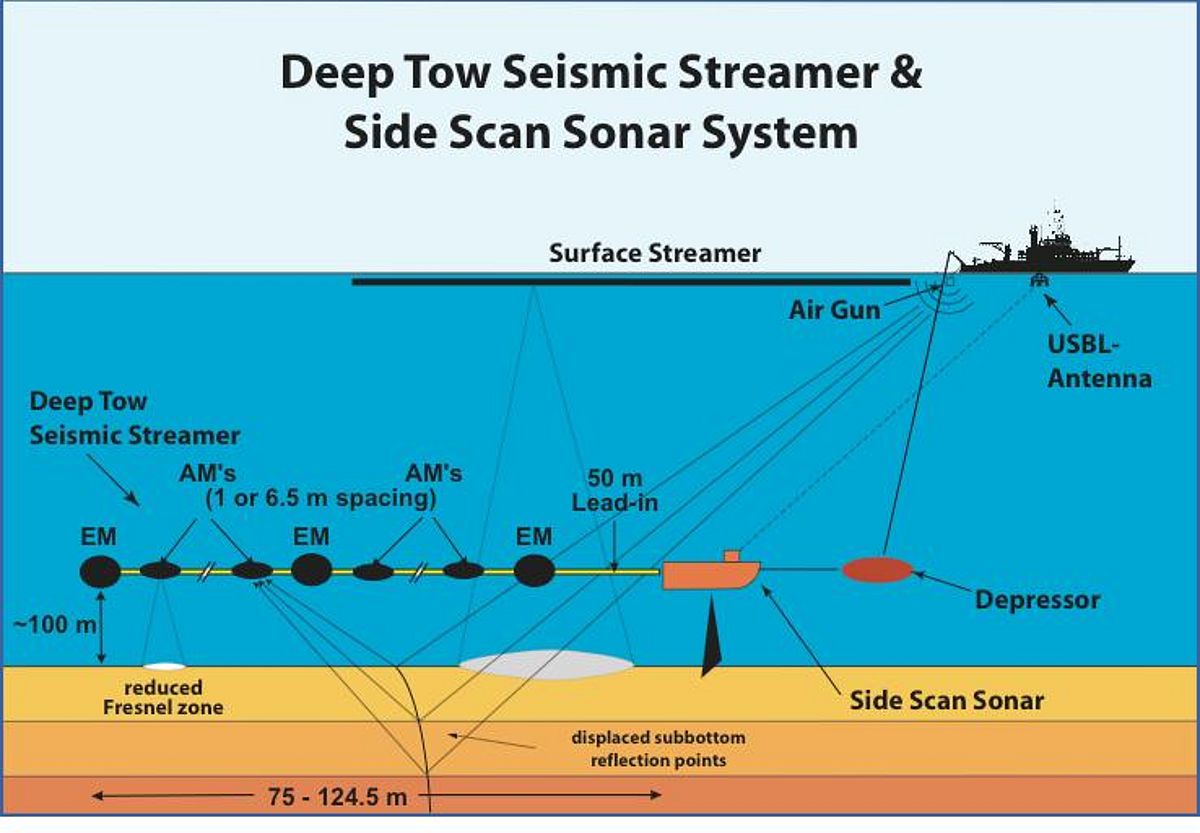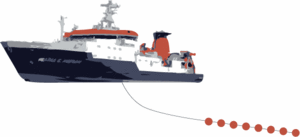The subprojects A2 explore hydrate accumulations for gas extraction and CO2 storage using geophysical methods.
For this purpose both seismic
and electromagnetic
SP A2.2: Controlled Source Electromagnetic (CSEM) for Gas Hydrate Evaluation and Quantification
methods will be optimized and applied.
Exploring hydrate accumulations for CO2 storage using deep-towed multichannel seismics (DTMCS)
The main goal of the project is to establish the technology for deep-towed seismic streamers in Germany. New developments concerning the intelligent management of digital electronics will be applied to ensure the most possible functionality even if parts of the instrument fail. Localisation of individual hydrophones shall be improved in order to increase the quality and resolution of the seismic data. In addition, better stability while towing and improved attitude information of the streamer are required for migration of the seismic data. Modules from an earlier development at GEOMAR do not allow these transformations and consequently a new development is undertaken in collaboration with SEND Offshore and K.U.M. Umwelt- und Meerestechnik. The new streamer shall subsequently be used for the exploration of hydrate reservoirs for CO2-sequestration.
Such deep-towed systems are required for a detailed structural analysis and quantification of potential CO2 dumps, i.e. hydrate reservoirs. For the study of these hydrate reservoirs deep-towed streamers offer a clear advantage in lateral resolution over conventional surface systems (see figure). Deep-towed multichannel seismic data allow a first estimation of the extent of hydrate reservoirs as well as a characterisation of the surrounding sediments. Further quantification of the hydrate distribution within the sediments will subsequently rely on additional approaches such as wide-angle seismics (OBS), controlled-source electromagnetics (CSEM, SP A2.2), sidescan sonar and drilling (SP A3).

Literatur
| Author | Title | Year | Journal/Proceedings | Reftype | DOI/URL |
|---|---|---|---|---|---|
| Breitzke, M. & Bialas, J. | A deep-towed multichannel seismic streamer for very high-resolution surveys in full ocean depth [Abstract] [BibTeX] | 2003 | First Break Vol. 21, pp. 59-65 | article | URL |
| Chadwick, A., Arts, R., Eiken, O., Williamson, P. & Williams, G. | Geophysical Monitoring of the CO2 Plume at Sleipner, North Sea [Abstract] [BibTeX] | 2006 | Advances in the Geological Storage of Carbon Dioxide, Vol. 65, pp. 303-314 | incollection | DOI |
| Petersen, C.J., Papenberg, C. & Klaeschen, D. | Local seismic quantification of gas hydrates and BSR characterization from multi-frequency OBS data at northern Hydrate Ridge [Abstract] [BibTeX] | 2007 | Earth and Planetary Science Letters Vol. 255(3-4), pp. 414-431 | article | DOI |
| Schwalenberg, K., Willoughby, E., Mir, R. & Edwards, N. | Marine gas hydrate electromagnetic signatures in Cascadia and their correlation with seismic blank zones [Abstract] [BibTeX] | 2005 | First Break Vol. 23, pp. 57–63 | article | URL |
| Talukder, A.R., Bialas, J., Klaeschen, D., Buerk, D., Brueckmann, W., Reston, T. & Breitzke, M. | High-resolution, deep tow, multichannel seismic and sidescan sonar survey of the submarine mounds and associated BSR off Nicaragua pacific margin [Abstract] [BibTeX] | 2007 | Marine Geology Vol. 241(1-4), pp. 33-43 | article | DO |
Controlled Source Electromagnetic (CSEM) for Gas Hydrate Evaluation and Quantification
The aim of subproject A2.2 is the assessment of submarine gas hydrate deposits with active marine electromagnetic methods. The assessment of suitable gas hydrate occurrences as a potential energy reservoir and as a deposit for the secure CO2 sequestration demands area-wide studies of the entire GHSZ. Open questions of particular importance are: How are gas hydrates distributed through the sediment section and what are the local concentrations? CSEM is a qualified method to sense the complete depth range of the GHSZ. The electrical conductivity or resistivity derived from CSEM data is a clear indicator where gas hydrates have formed in sufficient quantities. Gas hydrates are electrical insulating and replace the conductive pore fluid or parts of the sediment matrix. As a consequence the bulk resistivity of the gas hydrate formation will be enhanced. This has been observed using a bottom-towed electrical dipole-dipole system (Edwards, 1997, Yuan and Edwards, 2000) off the coast lines of Canada and New Zealand (Schwalenberg et al., 2005, 2008).
Methods
BGR Hannover is building a new bottom-towed CSEM system that is in particular sensitive to the upper few hundreds of meters below the seafloor. The system consists of multiple, cable linked electrical receiving dipoles towed at fixed offsets behind a transmitter dipole (see Figure). To study the deeper part of the hydrate zone around and below the BSR Geomar’s marine magnetotelluric (MT) receivers are modified to be used as broadband receiver stations for active source measurements. Integrating the CSEM results with hydroacoustics (A1), high resolution seismics (A2.2) and autoclave drilling results (A3) will provide a solid data base for detailed modelling of the gas hydrate distribution and subsequent gas hydrate quantification.
Literatur
| Author | Title | Year | Journal/Proceedings | Reftype | DOI/URL |
|---|---|---|---|---|---|
| Edwards, R.N. | On the resource evaluation of marine gas hydrate deposits using sea-floor transient electric dipole-dipole methods [Abstract] [BibTeX] | 1997 | Geophysics Vol. 62(1), pp. 63-74 | article | |
| Schwalenberg, K., Pecher, I., Netzeband, G., Poort, J. & Jegen, M. | Marine Controlled Source Electromagnetics on the Hikurangi Margin, NZ: Coincidence between Cold Gas Seep Sites and Electrical Resistivity Anomalies indicating Sub-Seafloor Gas Hydrate Deposits. [BibTeX] | 2008 | Extended Abstract, 6th ICGH Meeting, Vancouver, Canada | conference | |
| Schwalenberg, K., Willoughby, E., Mir, R. & Edwards, N. | Marine gas hydrate electromagnetic signatures in Cascadia and their correlation with seismic blank zones [Abstract] [BibTeX] | 2005 | First Break Vol. 23, pp. 57–63 | article | URL |
| Yuan, J. & Edwards, R.N. | The assessment of marine gas hydrates through electrical remote sounding: Hydrate without a BSR? [Abstract] [BibTeX] | 2000 | Geophysical Research Letters Vol. 27(16), pp. 2397-2400 | article |



